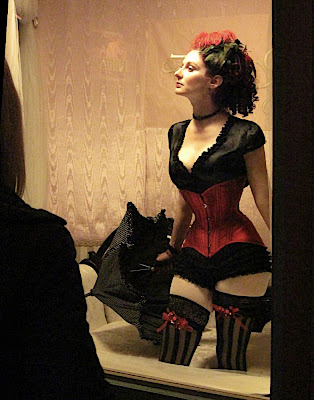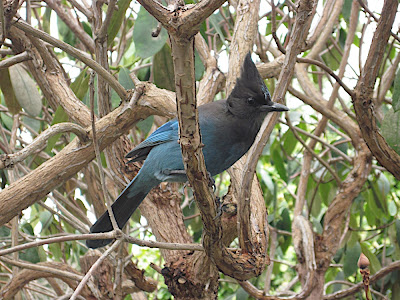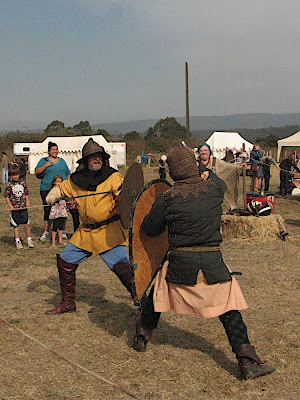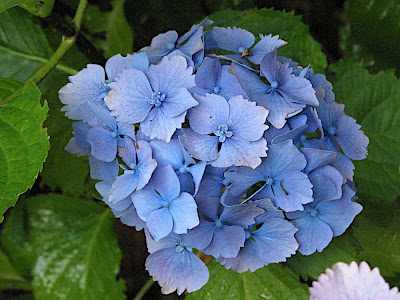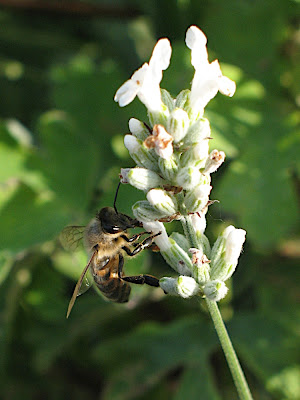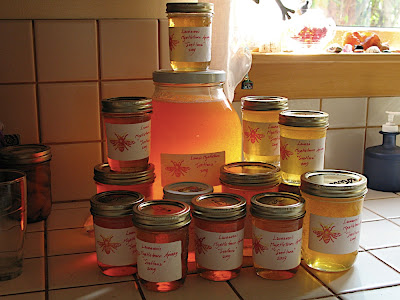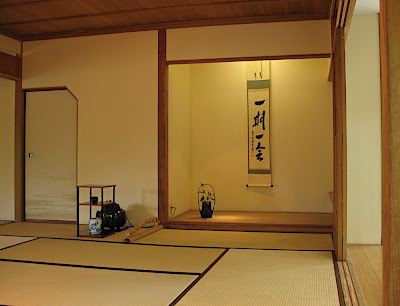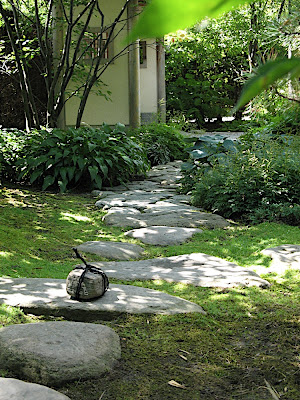
A week and a half ago, Pia, Holly and I flew to Alabama for the BirdFest. We'd been lured there by my Facebook friend Fran, who appears to be the head organizer. The area around Mobile sees large numbers of migratory birds come through on their way to and from their winter homes in South America. The birds aren't in their breeding finery in autumn, but I didn't mind the challenge of identifying birds in their wintry plumage.
On the day of our arrival, the weather was warm and humid. Mosquitoes would gather whenever we stood still. We wondered if we'd have any blood left in our veins after the weekend. As one birder had posted in a birding group, "the mosquitoes enjoyed a blood cocktail with a DEET chaser". However, the weather broke with a storm that evening, and the rest of our stay was relatively skeeter-free.

On that first evening, we attended a BirdFest social at the Five Rivers Delta resource Center. Fran spotted us as we approached, and gave us a warm welcome. It seems she had told a number of people about us. It seemed that everywhere we turned, someone would greet us with "are you the ladies who came all the way from California?". I'm not used to feeling so comfortable amid a crowd of strangers; everyone was lovely.

The next morning, Friday, we arose at O-dark thirty so we could make it to our first birding tour. In the morning we went to Weeks Bay for a boat ride up the Fish and Magnolia Rivers. It was a lot colder than I had expected it would be, and had left my vest & jacket in our room. But I tapped into my Scottish heritage (and life on Humboldt Bay), and found it wasn't so bad. It was a challenge to birdwatch with a canopy overhead and other birders in the way at times. But nice to see the area from the river, rather than from land. The weather had scared off a lot of birds, but we still saw some hardy specimens. My favorites were the fish crows, because of my fondness for the corbies. Brown pelicans, great blue herons, great egrets, mockingbirds and blue jays were in abundance, as they were throughout the weekend. It was a treat to see yellow-shafted flickers (aka yellowhammers) rather than our usual red-shafted variety.

After the boat tour, our guide took us to a pitcher plant bog. The featured phyto-carnivore is called white-topped pitcher plant, and is quite pretty. We also saw several autumn wildflowers like goldenrod, narrow-leaf sunflowers and lantana. The lantana is extremely popular with butterflies, and throughout the weekend we could cont on seeing lots of monarchs, gulf fritillaries and admirals enjoying the nectar. We also met several golden-silk spiders, also called banana spiders because of their shape and color. They are orb weavers, but look very different from our Humboldtian pumpkin spiders. There weren't many birds there, but we did see a Carolina wren and a blue grosbeak (just not very blue right now).

In the afternoon we took another boat tour, this time up Blakely River. The sky had cleared somewhat, but the wind was colder. I was glad to have picked up my warm clothes on the way. Of the new birds, we saw a (not-so-)purple gallinule, a blue-winged teal, a juvenile bald eagle, other raptors and a couple of soaring flocks of white pelicans. As we were leaving the boat at the end of the tour, one of the guides said that she found a great rat snake sitting on someone's bag. we hustled back to see it. It was lovely, but cold & shy, so the guide covered it up for the evening.
There was a banquet this evening, and we thought that it was being held at the Five Rivers Center. So we didn't feel too hurried after the tour. But when we got to the building, it contained only a few stragglers from an earlier event, and they sure didn't look like birders. Reviewing our info sheet, we found that the banquet was at the senior center in Fairhope, about 20 minutes drive away. As I drove, Holly called information to find out where the senior center was. Thank goodness for cell phones and 411! Upon arrival we found that we had plenty of time before the feasting began. A nice calming glass of wine was in order. We had a wonderful chat with a couple of the people from the Chamber of Commerce who were tending the bar. Then we checked out the silent auction items and chatted with Fran.
While standing in line for the buffet, the couple in front of us turned to us, and the wife asked "you're not from around here, are you?". We 'fessed up, and asked how she could tell. The lack of big hair and natural coloring were her clues, though that really didn't seem to be much to separate us from most people there. Anyway, we had another nice chat until we escorted our laden plates to table. Later, while waiting in the dessert line, the husband handed me his email address, offering to send us some good birding info. I looked at the addy, and had to ask if he knew our friend Kristin. She had told us about a birding friend in Mobile named Chazz, and here he was! Chazz told us that he was leading a trip on Sunday, and we arranged it so we could attend and then send BirdFest some more money later.
The next day we were on our own. First we went into Fairhope for the Bird Expo, and had more lovely conversations with people at the booths. We picked up some bird souvenirs, watched the raptor demo and looked at snakes. On a side street we found some nifty sculptures by local artist Bruce Larsen. We got some sandwiches and beer, then drove south to Fort Morgan.

The drive seemed long, especially the horrible stretch between Foley and Gulf Shores. Nothing but shopping malls and stop lights. After coming onto the sand spit, things improved, thought there are a lot of enormous vacation homes along the beach. We suspected that most got rebuilt bigger (and better?) after Hurricanes Ivan and Katrina, because they all looked new. In one area, we stopped to watch a raptor: I think it was a broad-winged hawk. Then a merlin flew by, then another and another.

We arrived rather late at Fort Morgan, and the bird banding station was shutting down for the day. One nice fellow came over to us and showed us the yellow-bellied sapsucker that he was about to release. Then he gave us some pointers, and went back to his job. Wandering through the woods, we heard and caught glimpses of several elusive little birds. Our luck had been better near where we parked the car. We saw our first eastern phoebe, blue-gray gnatcatcher and gray catbird. We even had a great blue heron fly into the trees nearby, and he stayed around for a while. Later reports informed us that all kinds of birds had been seen and/or banded earlier in the day, including a kettle of hawks that soared in the thermals overhead.

We then explored Fort Morgan, which guarded Mobile Bay during the American Civil War and up to WWII. It's mostly empty now, but there are lots of nifty rooms and alcoves to explore. We thought about walking to the beach from there, but the wind was howling and the sun was getting low.
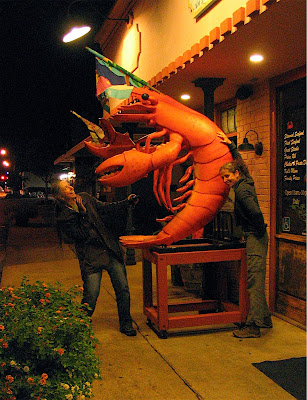
We had dinner back in Fairhope, at a place that claimed to have steamed seafood, but most of what we saw on the menu was deep fried. I didn't feel like ordering steamed clams at $1 a pop, so I had some mediocre gumbo. No wonder the place was so dismal on a Saturday night. The best thing about the place was the crawdad sculpture on the sidewalk.
On Sunday we were back in tour mode, gathering before dawn at Five Rivers for our date with Chazz. Our goal was the Blakely mud ponds, a Superfund site where nasty caustic mud & water from an old Alcoa plant is being remediated. The birds really like the secondary and tertiary ponds, where the pH has been lowered to more tolerable limits. Nonetheless, we were warned to not fall in the water unless we fancied a chemical burn. The site resembled the Arcata Marsh, though with more excavators and redder mud. Yes, that southern clay is red red red.

Our highlight was a black-bellied whistling duck mama with 15 fledging ducklings. Chazz said that's the first evidence that these whistling ducks breed on Mobile Bay (if not Alabama). Those ducklings were still to young to fly, so couldn't have come from somewhere else. In a thicket of trees we found all kinds of little songbirds. Unfortunately they move fast, so identifying or even seeing them was often difficult. I was pleased to recognize a ruby-crowned kinglet and got better at spotting my new friend the blue-gray gnatcatcher. In the reeds we saw a sora, which is a modest little marsh bird. This poor fellow had a broken wing dragging in the water. They don't fly much, so for now he was OK. However, our Sibley Guide says they don't winter on Mobile Bay.
Chazz offered to take us to another site that afternoon, so after the group tour we followed him through Mobile to get some lunch, then to his house to eat it. We settled into patio chairs to watch the birds, and Martha ("Mrs. Chazz") kindly brought us some hot chai to fend off the cold wind. After watching the cardinals, blue jays, chickadees and chickens for a while, we saddled back up and went to Muddy Creek.
There wasn't much creek, but there certainly was mud. Fortunately there is a boardwalk winding through the swamp. We continued to see many now-familiar birds like the phoebe and catbird. I caught enough of a look to know I was seeing a pileated woopecker before he took off again. Although they also live in the woods in Humboldt, I've never seen one before. I also saw a white-eyed vireo, which is aptly named for his strikingly pale eye. There were more golden-silk spiders and butterflies.
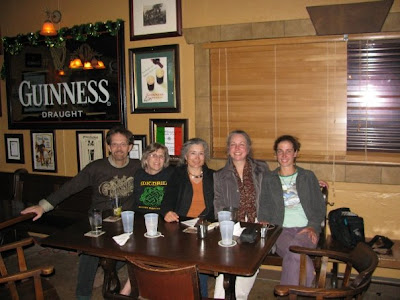
In the evening we went to McSharry's a pub in Fairhope. Fran's husband Tom plays fiddle in a wonderful Celtic band called Mithril, and usually plays in a session at McSharry's on Sunday night. Fran joins in with the bodhran. The waitress Barbie was wonderful, and I don't think it was simply due to the announcement of her engagement to the owner Ronan. She made sure we got the last piece of bread pudding to share. It's topped with a Jameson whiskey sauce which made it even more wonderful. Fran and Tom come over to visit a few times during a break, and we had a grand time. Sadly, the music was over all too soon, and it was time to go home.

On Monday we were on our own again. We finally had a warm and un-windy day. Our goal was Dauphin Island, but first we made a detour to see an alligator and then to Battleship Park. There's a boardwalk along a creek in Spanish Fort which a birding couple had told us about. The morning was cool, but we got to see one alligator sunning himself. At Battleship Park we didn't tour the USS Alabama, but were scanning the mudflats for more wading birds. There's a handy elevated platform, and we got to see our usual great blue herons and great egrets. But then there were white ibises, a tri-colored heron and a little blue heron. Sadly, no roseate spoonbills, which had been seen there a day or two before.

At the Airport Marsh on Dauphin Island we hoped to see a reddish egret, but were out of luck. We consoled ourselves by watching hermit crabs scoot about through the mud, and even what looked to be a hermit crab orgy. Maybe they were fighting, but I like to think that they were procreating. Earlier Pia had put a shell in her pocket, thinking that it was empty. When she went to pull it out to check, she found that the resident hermit crab had grabbed onto a sizeable bit of fabric. It took a fair bit of patient work to get him to let go.
At Shellmound Park we saw more yellow-bellied sapsuckers and lots of elusive little sputzies. While we sat watching the birds in a clearing of sorts, a woman showed us a yellow-billed cuckoo. Unlike all the nervous little birds, the cuckoo sat quiet and still for the longest time. Not easy to spot, but once you do, you get a good long look.

Our last spot on Dauphin Island was the Audubon refuge. The trail leads through a long-leaf pine forest to dunes and the beach. It seemed odd, then very naturally Gulf coast to see small palms and magnolias in the midst of a pine forest. The beach sand here is very white - all quartz sand, I believe. It's so very different from our gray sand & pebble beaches. I'd never thought much about the color of seawater in the Gulf, but hadn't expected the color of weak coffee. But it makes sense when I thought of all the water coming through the bayous and marshes, laden with all kinds of organic matter. It was warm, too, unlike our numbingly cold green water.

Near sunset we rejoined the car and set off to Gulfport, whence we were to fly out in the morning. Our return was fairly uneventful, thank goodness. Now we need to figure out where we're going for our next birding trip.


